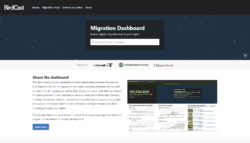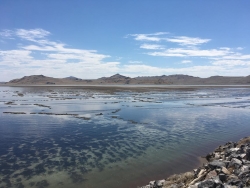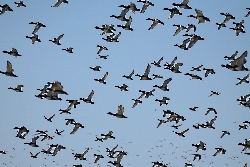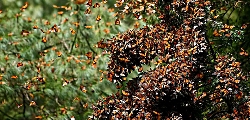Canyonlands National Park
Courtesy US National Park Service,
Emily Ogden, Photographer
Canyonlands is one of many parks in southern Utah with the International Dark Sky Park designation
https://dashboard.birdcast.info/
Courtesy BirdCast, The Cornell Lab of Ornithology
Cornell University
Songbirds migrate at night to avoid predators, air turbulence, and daytime heat. Down here on the ground we are unaware of the miraculous and essential voyagers flying up to 10,000 feet above us, but thanks to dedicated scientists collaborating for years on end we have free access to the data and graphs of these massive population shifts. The BirdCast Dashboard uses weather radar to track bird migrations, providing real time data showing peak migrations at the website dashboard.birdcast.info.
Did you know that World Migratory Bird Day is celebrated in May and October? Those are the peak months for spring and fall migrations, and the magnitudes of those flocks are considerable. Two thirds of songbirds migrate at night, and on the evening of Sunday, May 15, 2022, one million one hundred and fifty one thousand five hundred (1,151,500) birds crossed Cache County, Utah! Yes, 1,151,500 birds crossed Cache County, Utah, in one night!
It’s important to know when migrations are occurring because skyglow from artificial lighting causes bird disorientation and millions of bird fatalities each and every year. The declining bird population is problematic for many reasons, not least of which because some of the most intrepid travelers like the three-inch-long Rufous Hummingbird, which travels 3,900 miles each way from Alaska to Mexico, are keystone species with ecosystem services such as pollination and consumption of pests such as aphids and mosquitoes.
The Bobolink travels 12,500 miles to and from southern South America every year – those imperiled birds breeding at the west end of Logan may travel the equivalent of 4 or 5 times around the circumference of the earth throughout their lifetime. They come to Cache Valley for the habitat, stay to raise their young, and then head back to their distant winter feeding grounds.
A few top-notch steps toward bird-friendly living include the prevention of light trespass and skyglow, especially from 11 p.m. to 6 a.m., March – May, and August – October. Close curtains to prevent the indoor light from escaping, and avoid blue light outdoors – choose warm white or amber lights, and shield light bulbs to direct light downward. Motion-activated light bulbs are a great way to safely light the way while cutting down on unnecessary outdoor lighting, especially since there’s no clear scientific evidence that outdoor lighting reduces crime. Excess light, on the other hand, is a crime, and light trespass is an enforceable infraction. Light pollution is harmful to humans and deadly for birds.
Logan Mayor Holly Daines signed a Proclamation to Dim the Lights for Birds at Night because reducing skyglow and light trespass saves energy and birds by reducing the often fatal disorientation caused by artificial light.
Dark Skies are filled with bright stars, so by jingles, what say we all “Dim the lights for birds at night!”
I’m Hilary Shughart with the Bridgerland Audubon Society, and I am Wild About Utah!
Credits:
Images: Milky Way above Chesler Park, Canyonlands National Park, Courtesy US National Park Service, Emily Ogden, Photographer, https://www.nps.gov/media/photo/gallery-item.htm?id=286169fc-2bab-40e0-bf8b-a13b5170aeb3&gid=2ADECB87-1DD8-B71B-0B09BD0B18C96667
Screenshot: BirdCast Migration Dashboard, Courtesy BirdCast, The Cornell Lab of Ornithology, Cornell University, https://dashboard.birdcast.info/
Featured Audio: Courtesy & Copyright © Kevin Colver, https://wildstore.wildsanctuary.com/collections/special-collections/kevin-colver
Text: Hilary Shughart, President, https://bridgerlandaudubon.org/
Additional Reading: Hilary Shughart and Lyle Bingham, https://bridgerlandaudubon.org/
Additional Reading
WildAboutUtah pieces by Hilary Shughart, https://wildaboututah.org/author/hilary-shughart/
Miller, Zach, Dark Sky Parks, Wild About Utah, Nov 2, 2020, https://wildaboututah.org/dark-sky-parks/
Leavitt, Shauna, Natural Quiet and Darkness in our National Parks, Wild About Utah, May 6, 2019 & August 3, 2020, https://wildaboututah.org/natural-quiet-and-darkness-in-our-national-parks/
Rask, Kajler, Dark Skies, Wild About Utah, Jan 1, 2018, https://wildaboututah.org/dark-skies/
Dark Skies, Bird-Friendly Living, Advocacy, Bridgerland Audubon Society, May 2022, https://bridgerlandaudubon.org/our-projects/advocacy/bird-friendly-living/dark-skies/
Dim the Lights for Birds at Night, Bridgerland Audubon Society, May 3, 2022, https://bridgerlandaudubon.org/our-projects/advocacy/bird-friendly-living/dark-skies/
International Dark Skies Association, Utah Chapter, https://utah.darksky.ngo/
Welzbacker, Hannah, Tracking a Night-Time River of Birds, Cool Green Science, The Nature Conservancy, April 13, 2021, https://blog.nature.org/science/2021/04/13/tracking-a-night-time-river-of-birds/?fbclid=IwAR18LKCQUmSlb-hHM1u4FXfVe-GqyWTwiPx91obUQbq2uB9kcPU2djlCnlk
BirdCast Dashboard, The Cornell Lab of Ornithology, Cornell University, https://dashboard.birdcast.info/
Global Bird Collision Mapper, Fatal Light Awareness Program (FLAP) Canada, https://birdmapper.org/app/
Lowe, Joe, Do Hummingbirds Migrate?, American Bird Conservancy, September 12, 2019, https://abcbirds.org/blog/do-hummingbirds-migrate/
Bobolink (Dolichonyx oryzivorus), “Bobolink is one of the few grassland-dependent species of concern that breed in Utah”, Utah Division of Wildlife Resources, April 20, 2020, https://wildlife.utah.gov/pdf/sensitive_species/birds_bobolink_2020.pdf
Bobolink (Dolichonyx oryzivorus), All About Birds, Cornell Lab of Ornithology, Cornell University, https://www.allaboutbirds.org/guide/Bobolink
Lighting, Crime and Safety, International Dark-Sky Association, https://www.darksky.org/light-pollution/lighting-crime-and-safety/#:~:text=There%20is%20no%20clear%20scientific,cost%20a%20lot%20of%20money
2022 Proclamation “Dim the Lights for Birds at Night”, https://bridgerlandaudubon.org/dim-the-lights-for-birds-at-night/
The use of the “by jingles” exclamation is in homage to Warren Dahlin’s moving Moth Radio Hour story “Open My Eyes”, in which he “makes a friend who stays with him in life and in death.” Heard on Utah Public Radio (5/28/22), The Moth, https://themoth.org/radio-hour/squeaky-wheels-1
Owens, Avalon & Cochard, Précillia & Durrant, Joanna & Farnworth, Bridgette & Perkin, Elizabeth & Seymoure, Brett. (2019). Light pollution is a driver of insect declines. Biological Conservation. 241. 108259. 10.1016/j.biocon.2019.108259. https://doi.org/10.1016/j.biocon.2019.108259






